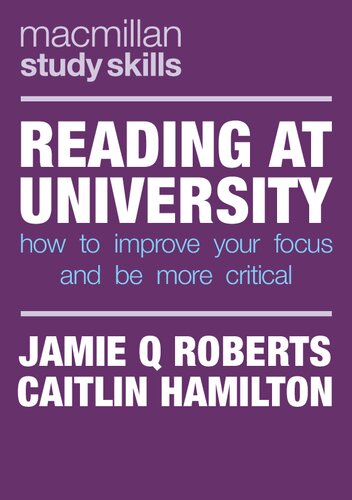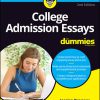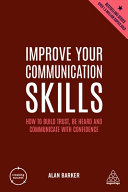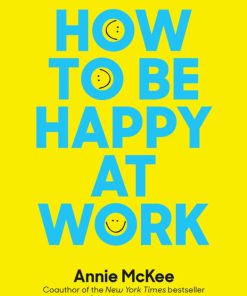Reading at University How to Improve Your Focus and Be More Critical 1st Edition by Jamie Roberts, Caitlin Hamilton 1352009161 9781352009163
$50.00 Original price was: $50.00.$25.00Current price is: $25.00.
Reading at University How to Improve Your Focus and Be More Critical 1st Edition by Jamie Roberts, Caitlin Hamilton – Ebook PDF Instant Download/Delivery: 1352009161, 9781352009163
Full download Reading at University How to Improve Your Focus and Be More Critical 1st Edition after payment

Product details:
ISBN 10: 1352009161
ISBN 13: 9781352009163
Author: Jamie Q Roberts; Caitlin Hamilton
This concise and practical text will equip students with the effective reading strategies they need when preparing for their university assessments. It dispels assumptions often made about the nature of reading at university, and provides an overview of the culture of academic reading, note-making, and what markers expect. This text provides support for reading structured around the process of crafting an assignment, including reading critically and developing an academic voice.
Reading at University How to Improve Your Focus and Be More Critical 1st Table of contents:
PART 1 Before You Read
Chapter 1 Twelve Dubious Assumptions About Reading at University
Introduction
The assumptions
Conclusion
Chapter 2 The Purpose of Universities, the Nature of Academic Publishing and What This Means for Your Reading
Introduction
The purpose of universities and how this relates to reading
The journey to a published article
Conclusion: so how does understanding the purpose of universities and the publishing process help me read at university?
Chapter 3 Marking Criteria Related to Reading
Introduction
The marking criteria
Conclusion
Chapter 4 The Different Sources Encountered at University
Introduction
Thinking about the authority of sources
Standard academic sources
Non-peer-reviewed sources and ‘grey literature’
Are there sources I should never use?
Conclusion
Chapter 5 Optimizing the Environment in Which You Read
Introduction
Where and when to read
Reading and technology: to screen or not to screen
Maintaining concentration while reading
Conclusion
PART 2 Reading for Your Classes and Assignments
Chapter 6 Making Notes When You Read
Introduction
The tragic characters of the bad-note-making world
What do good notes help you achieve?
Note-making in different contexts
Making notes for your assignments
The benefits of making digital notes: accessibility, speed, searchability, reference assistance
Combining note-making techniques
When it’s ok not to make notes
Conclusion
Chapter 7 Reading to Work Out What a Source Is Generally About
Introduction
When it is useful to read for the ‘bumps’
The different structures of sources: scientific versus essayistic structures
The ‘first pass’: six questions to help you work out what a source is about
Worked examples of how to read for the bumps
The ‘second pass’: overviewing
Conclusion
Chapter 8 Reading in Depth
The central advice: read with a purpose
Reading key sources: ease your way in by reading summaries, general analyses and secondary sources
Begin by reading for the bumps and overviewing
Read critically
Reread
Make notes
A note about the challenges of reading theory or philosophy
Conclusion
Chapter 9 The Assignment-Production Process: Reading, Planning and Writing
Introduction
Some words of encouragement
The research process: the dialectical relationship between reading and writing
The assignment-production process
An extended example illustrating the early stages of the assignment-production process
Some additional questions you might have
Conclusion
Chapter 10 Reading Critically (Part 1): Different Ways of Using Information in Your Writing, Including Critiquing
Introduction
Using information in your assignments
A few more words about making evaluations or critiques
Specific things to evaluate in a source
But what is ‘analysis’?
But I don’t have any opinions!
Conclusion
Chapter 11 An Extended Activity About How to Find, Evaluate and Use Information from a Single Source
Introduction
Activity instructions
The article: ‘Three ways to accelerate science’ by Cori Bargmann
Our responses to the questions
Chapter 12 Reading Critically (Part 2): Comparative Reading and Synthesis
Introduction
Comparative reading: identifying similarities
Comparative reading: contrasting (and more evaluating)
Synthesizing
An extended worked example demonstrating synthesis
Chapter 13 Reading to Understand Your Field
Introduction
What exactly is a ‘field”?
How can I begin to understand the ‘shape’ of my field?
Conclusion
Chapter 14 Reading to Write: Developing Your Own Academic Voice by Imitating Good Writers
Introduction
So, what does academic writing look like?
Your academic voice and plagiarism
Conclusion
Chapter 15 Reading Widely to Enrich Your Studies and Life
Introduction
The benefits of reading widely
How to read (and watch) widely
Conclusion
People also search for Reading at University How to Improve Your Focus and Be More Critical 1st:
9 reading strategies
how does reading improve your creativity
how to improve my reading skills in english
3 reading skills
Tags:
Jamie Roberts,Caitlin Hamilton,Reading,University
You may also like…
Uncategorized
Relationships & Lifestyle - Personal Growth & Inspiration
Business & Economics - Management & Leadership
Focus on Them : Become the Manager Your People Need You to Be 1st Edition Ryan Changcoco
Relationships & Lifestyle - The Art of Communication
Uncategorized
Risky Strategy Understanding Risk to Improve Strategic Decisions 1st Edition Jamie Macalister
Relationships & Lifestyle - Diet & Nutrition
Your Turn How to Be an Adult 1st Edition Julie Lythcott Haims
Children's Books - Education & Reference
Uncategorized











